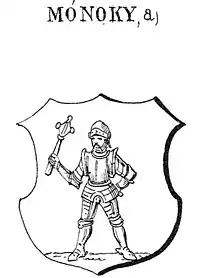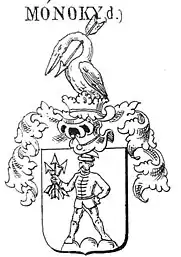House of Monok
The House of Monok (Hungarian: Monoky Család), alternatively spelled Monaky, Monoky, or Monoki was a Hungarian noble dynasty which held power from the 13th century until the 17th century.[1] The earliest ancestors of the House of Monok are of the Clan of Bogát, founded in the late 9th century. The Bogátradvány genus are the predecessors of the Monoky along with other Hungarian noble families, including the House of Rákóczi.[2]
| House of Monok | |
|---|---|
 | |
| Parent family | Bogátradvány genus |
| Founder | Elijah Monoky |
| Current head | Jesse Monek |
| Titles | Count
Lord over Monok Lord over Bekecs Lord over Szada Lord over Megyaszó Lord over Lúcz Hereditary Baron |
| Cadet branches | House of Dobi |
Name
The origins of the village name "Monok" are uncertain. Allegedly, the name of the village is derived from Slavic monoh meaning monk.
The name of the family originates from the family taking on the name of the village, the first documented person with such a name was Illés Monoky who lived during the 13th century. The House of Monok is documented as being originally derived from the Bogát-Radvány (genus) with land being given to the family, namely the village of Monok, for military service. The family, then adopted the name of the village of which they had ownership of leading the family to become known and documented as the Monoks.
The first documented person with such a name was Elijah Monoky who lived during the 13th century.[3]
History
Origins and Early History
Lászlo Makkai, a Hungarian historian, through his work, Transylvania in the Medieval Hungarian Kingdom (896-1526), mentions the tribes regarding Bogát (Bugat rex) as a Gyula of the Magyar tribal confederation. Additionally, the writings of Simon of Kéza, on the pre-history of the Monoks, include the Bogát-Radván Clan, confirming the Bohemian and Transylvanian origins for many prominent Hungarian noble families including those of the Monok family as being derived from the Magyar tribe of Keszi. Based upon the language used in the texts of Simon of Kéza, the origins of the Bogátradvány Clan are during Migration Period, the Bogátradvány Clan of the tribe of Keszi settled in the East during their conquests in Europe. The family of Bogát, therefore, has its origins somewhere in the 300s Eastern Europe within the ruling family of the tribe of Keszi, one of the seven Magyar tribes.
Simon of Kéza, a Hungarian chroniclor of the 13th century, wrote that the founder of the Monoky was one of the nobles of Árpád, however, a theory exists which states that the Monoky dynasty's founders were refugees from Moravia and Tálya who arrived under Prince Monok after the Tatar invasion. The village of Monok's website states includes the Tatar Theory but ultimately concludes that the Bogát and Radvány families "moved from Lúc to Monok and founded the prestigious Zemplén family, which survived for several centuries under the name Monaky."
The Monok family's earliest documented progenitor is in 921 with the Gyula of the Hungarian tribal federation, Bogát, a Hungarian General and ruling Prince who was then hired by King Berengar of Italy to assist in his war against the rebellious barons of Berengar. Bogát initiated an alliance with King Berengar sometime after 904 but prior to 918. With Bogát came Tarkacsu, also known as Dursan by the Italians, and, together, they crushed the rebellious barons of the Italian realm, namely, Adelbert and Gislebert, and upon returning home, Bogát was awarded a tract of land (which would one day become Monok) in North-Eastern of Hungary for his bravery, thus becoming the progenitor of the Monoks.
It is known that the Monokian branch and the Rákóczian branch of the wider Bogát-Radvánian dynasty were in possession of lands in Bohemia prior to their arrival in Hungary, which were given royal donation. In their early history, the Monok dynasty motto “With Loyalty and Valor” came about from a jousting tournament held after the coronation of King Stephen I of Hungary, this motto would be associated with the family and their cadet branches thereafter.
Lords in Monok
The person of Illés is typically listed in documentation under the name of either Alexander or Elijah.[4][2] The names of the descendants on all genealogical trees, however, perfectly match the descendants of the individual as well as significant dates in the family, which means that both are the same person yet identified differently. During the Tatar invasion, Elijah Monoky held ownership and Lordship over Monok, both the village and family of Monok were not struck nor pillaged by Mongol forces during this conflict. Count Ladislaus, the son of Elijah, would go on to be the first member of the Monok dynasty to extensively use the name "Monok" in records. Lord Elijah Monoky is mentioned in Hungarian records[2] as being born between 1217 and 1277. Among the sons of Ladislaus (d. 1310 and 1333), Michael I was the Viscount of Sáros, while Simon was the Royal Altar Master. Sandrin, son of Michael I, was a master carpenter. Among Sandrin's sons, Stephen was a guard cannoneer in Fehérvár, and Peter was a prominent Catholic clergyman of Szabolcs.[5][2] The successor of Ladislaus I was his son, Simon Monoky, held Lordship over the Monok lands, which he led for a great part of the mid 14th century. During his tenure as Lord, Simon would obtain ownership of Bekecs and ownership of Szada prior to his death in 1369.

Michael II's son, Nicholas I, would inherit Monok when his father died, and Nicholas I's son, Michael Monoky de Monok III, reigned in the latter half of the 1400s. Mihály Monoky de Monok II held power until his death in the early 1500s, and during his tenure became a Baron of Lúcz, due to the Monoks' blood relation to the House of Lúcz.[6] However, the Barony of Lúcz would later be lost near permanently after the death of the Monok main line in the 17th century. It is from Mihály Monoky de Monok II that the first coat of arms of the Monok dynasty is documented.
Extinction of the Monoky main line
The House of Monok and their descendants were raised to hereditary nobility at the rank of Baron, from King Ferdinand II of Hungary on August 16, 1625, as a result of the service of Nicholas II, 1st Baron of Monok, (d. 1643), a Captain of Ónod, to the Kingdom of Hungary.[7] However, the main male line, consisting of the descendants of John III would die out in 1643, Baron Nicholas III would have prospered.[8] Nicholas Monoky de Monok II and his two brothers would have no male heir, thus leading to the Andrássy family obtaining the Barony of Monok through marriage.
John Monoky de Monok III would become the next Baron, it is noted that he rebuilt the castle of Monok. Another achievement of John III was that of becoming the Captain of the castle of Fülek during military service.[2] Nicholas II, son of John III, then adopted the title of Baron of Monok, later achieving Baronship through his connections and alignment with King Ferdinand II of Hungary, consisting of service in the military and holding an administrative position.[9] In 1625, when Miklos II received the title of Baron with a red seal from King Ferdinand, the title was hereditary and thus went to himself and his family, allowing for other family members to inherit the title.[9]
Consolidation and Continuation

Due to Nicholas II and his brothers only having daughters, the main line fell apart, though cadet branches such as the Doby (also written as "Dobi") would still prosper.[10]
Péter Monoky de Monok's son, Miklós Monoky de Monok, was of the same generation of the famous Baron Miklós Monoky de Monok. Francis Mónoki would have to contend with the continuation of these issues in his own life. Among what is known of Francis II is his coat of arms which was documented in 1694, 1703, and 1707.[8]
See also
References
- Ráth 1860, p. 551-4.
- Monoky Család. (Monoki. †) Arcanum, National Archives of Hungary. Retrieved 21 December 2022.
- Ráth 1860, p. 551-2.
- Karácsonyi, János. (1901) "A magyar nemzetségek a XIV. század közepéig." A Pechujfalusi Pechy Csalad Honlapja, pechy-de-pechujfalu.hu, https://www.pechy-de-pechujfalu.hu/myfiles/htmls/karacsonyi/karaxw-Title.html.
- Ráth 1860, p. 553.
- Ráth 1860, p. 553-4.
- "Monaky de Monak Miklós | Libri Regii | Hungaricana". archives.hungaricana.hu (in Hungarian). Retrieved 30 January 2023.
- Mónoky v. Mónok Arcanum, National Archives of Hungary. Retrieved 21 December 2022.
- Ráth 1860, p. 554.
- Doby család Arcanum, National Archives of Hungary. Retrieved 21 December 2022.
Sources
- "Doby család." Arcanum, National Archives of Hungary, https://www.arcanum.com/en/online-kiadvanyok/Nagyivan-nagy-ivan-magyarorszag-csaladai-1/harmadik-kotet-1435/doby-csalad-203D/.
- Karácsonyi, János. (1901) "A magyar nemzetségek a XIV. század közepéig." A Pechujfalusi Pechy Csalad Honlapja, pechy-de-pechujfalu.hu, https://www.pechy-de-pechujfalu.hu/myfiles/htmls/karacsonyi/karaxw-Title.html.
- "Monoky Család. (Monoki. †)." Arcanum, National Archives of Hungary, https://www.arcanum.com/hu/online-kiadvanyok/Nagyivan-nagy-ivan-magyarorszag-csaladai-1/hetedik-kotet-5828/monoky-csalad-monoki-6B2C/.
- "Mónoky v. Mónok." Arcanum, National Archives of Hungary, https://www.arcanum.com/hu/online-kiadvanyok/Siebmacher-siebmacher-wappenbuch-1/der-adel-von-ungarn-magyarorszag-2/csaladok-29/monoky-v-monok-5387/.
- Ráth, Mór. Magyar Elektronikus Könyvtár (MEK) / Hungarian Electronic Library, Nagy Iván, https://mek.oszk.hu/09300/09379/pdf/mo_csaladai_07.pdf.